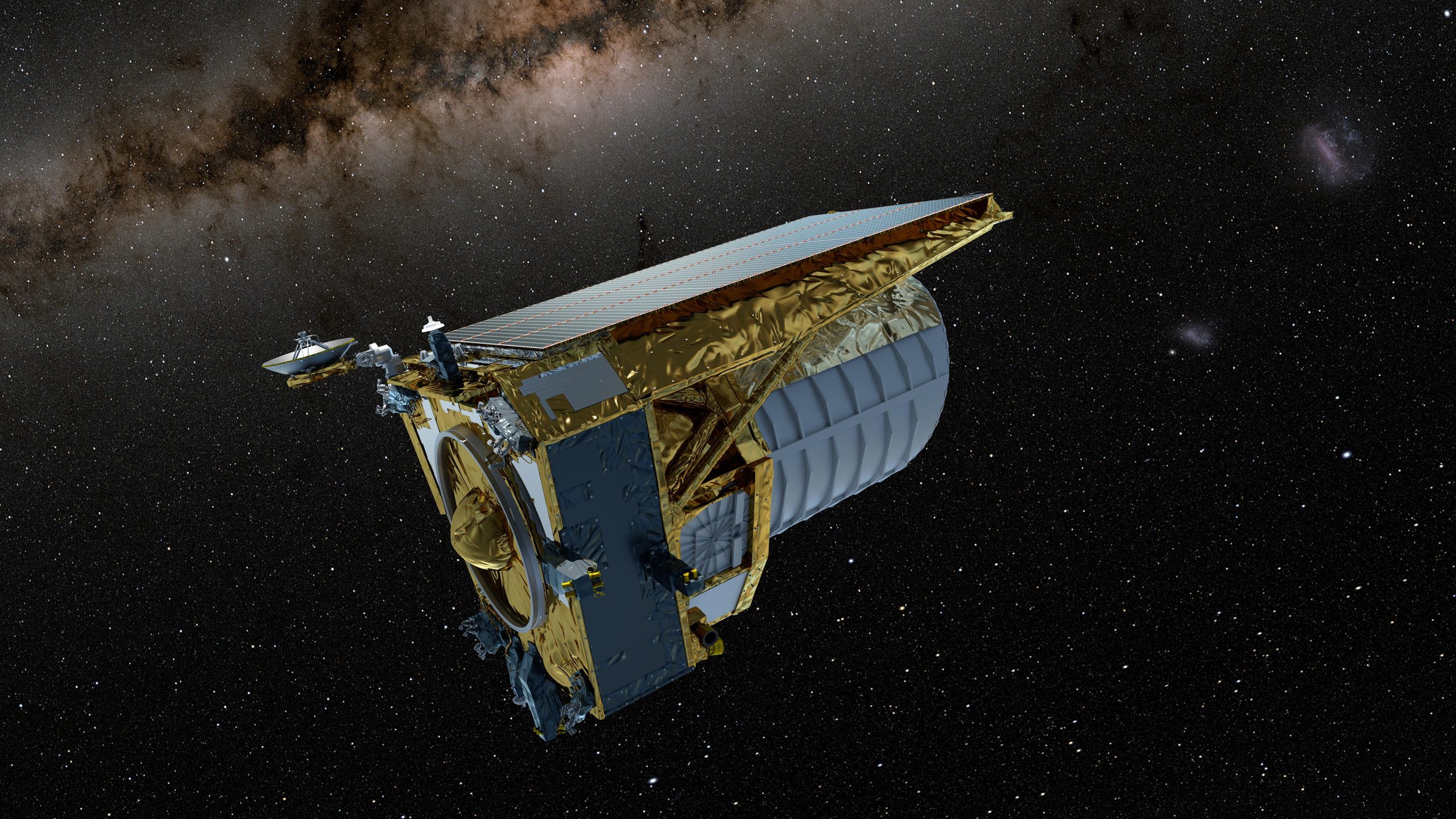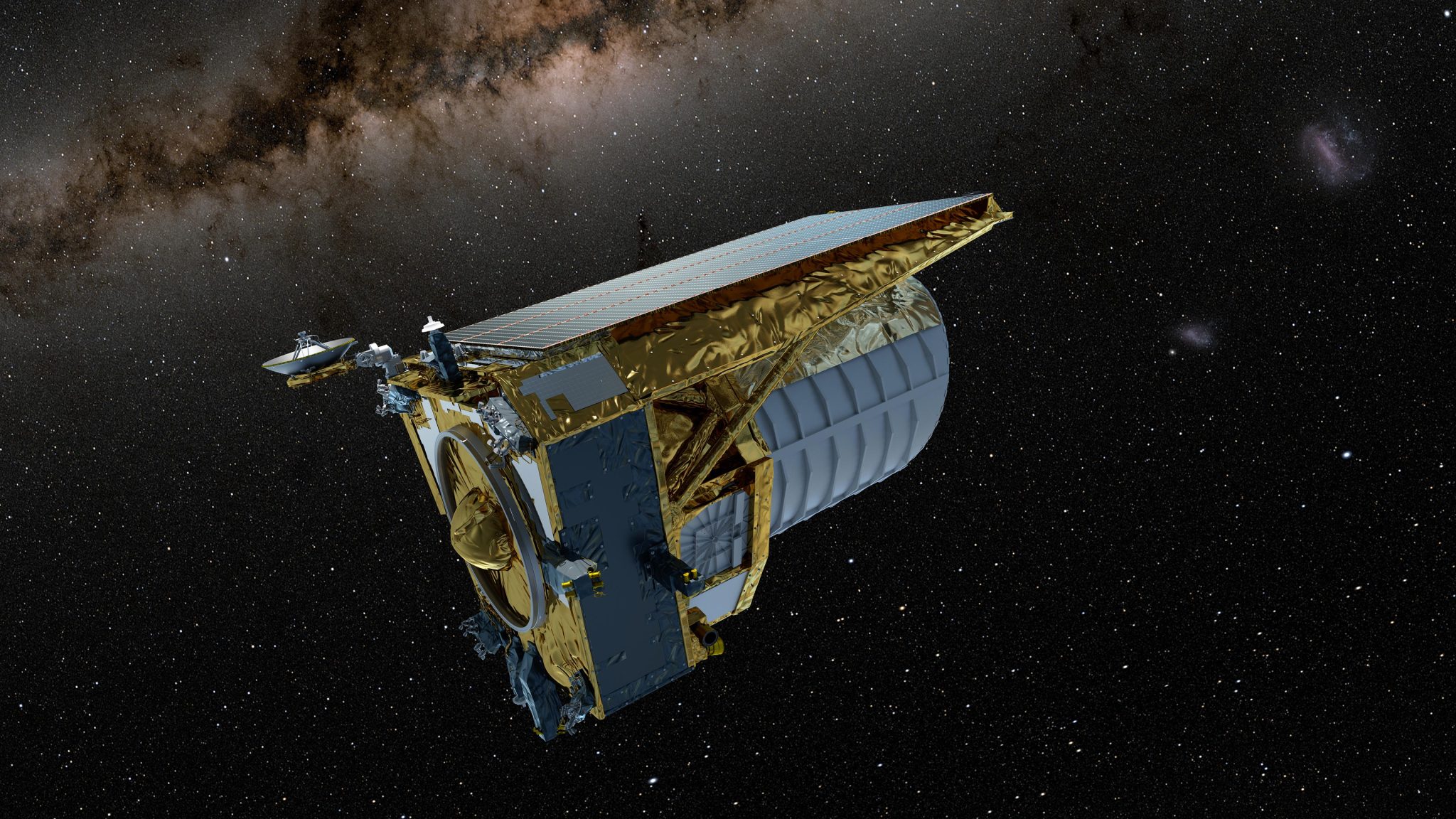
Pesawat ruang angkasa Euclid mulai diluncurkan – Teleskop luar angkasa baru akan menjelajahi alam semesta yang gelap

Kesan artis tentang misi luar angkasa Euclid. Euclid dirancang untuk melihat jauh dan luas untuk menjawab beberapa pertanyaan mendasar tentang alam semesta kita: Apa itu materi gelap dan energi gelap? Peran apa yang mereka mainkan dalam pembentukan jaring kosmik? Misi tersebut akan membuat katalog miliaran galaksi jauh dengan memindai melintasi langit dengan teleskop sensitifnya. Kredit: ESA
itu[{” attribute=””>European Space Agency’s Euclid spacecraft has been fueled with hydrazine and gaseous nitrogen in preparation for launch on a SpaceX Falcon 9 this summer. The highly toxic hydrazine, used for propulsion and spacecraft disposal, is handled by experts wearing protective suits.

ESA’s Euclid gets fueled inside an Astrotech facility near Cape Canaveral in Florida (USA) ahead of its launch on a SpaceX Falcon 9 this summer. Credit: Astrotech (Mack Russo)
ESA’s Euclid spacecraft is supplied with two types of propellant: hydrazine and gaseous nitrogen. Ten hydrazine thrusters will provide chemical propulsion to complete the journey to Sun-Earth Lagrange point L2, perform monthly maneuvers to stay in orbit, and dispose of the spacecraft at the end of the mission’s life. 140 kg of hydrazine is stored in one central tank. Fueling the spacecraft is a delicate operation because the hydrazine fuel is highly toxic. The task has to be carried out by experts who each wear a self-contained atmospheric protective ensemble, or ‘scape’ suit.

The Euclid spacecraft is set to orbit the Sun-Earth system’s second Lagrange point (L2), situated 1.5 million kilometers from Earth opposite the Sun. This equilibrium point will allow Euclid’s sunshield to continuously block sunlight and light from Earth and the Moon, thus pointing its telescope towards the vast expanse of deep space and ensuring stability for its onboard instruments. Credit: ESA
ESA’s Euclid will orbit the second Lagrange point (L2), 1.5 million kilometers from Earth in the opposite direction to the Sun. L2 is an equilibrium point of the Sun-Earth system that follows Earth around the Sun.
In its orbit at L2, Euclid’s sunshield can always block the light from the Sun, Earth, and Moon while pointing its telescope towards deep space, ensuring a high level of stability for its instruments.
At L2, Euclid joins ESA’s Gaia mission and the ESA/NASA/CSA James Webb Space Telescope, which are also orbiting around this equilibrium point, each following well-separated trajectories.
- ESA’s Euclid gets fueled inside an Astrotech facility near Cape Canaveral in Florida (USA) ahead of its launch on a SpaceX Falcon 9 this summer. Credit: Astrotech (Mack Russo)
- ESA’s Euclid gets fueled inside an Astrotech facility near Cape Canaveral in Florida (USA) ahead of its launch on a SpaceX Falcon 9 this summer. Credit: Astrotech (Mack Russo)
- ESA’s Euclid gets fueled inside an Astrotech facility near Cape Canaveral in Florida (USA) ahead of its launch on a SpaceX Falcon 9 this summer. Credit: Astrotech (Mack Russo)
- ESA’s Euclid gets fueled inside an Astrotech facility near Cape Canaveral in Florida (USA) ahead of its launch on a SpaceX Falcon 9 this summer. Credit: Astrotech (Mack Russo)
To deliver images of the highest quality, the Euclid spacecraft must ensure a very precise and stable pointing. For accomplishing this, Euclid will use six cold gas micro-propulsion thrusters fed by nitrogen stored in four tanks at high pressure. The stored 70 kg of nitrogen will ensure a mission lifetime of at least six years.
Euclid is a space telescope developed by the European Space Agency (ESA), with a primary objective of delving into the mysteries of the dark Universe. The mission aims to produce the most extensive and accurate 3D map of the Universe ever created, capturing 10 billion years of cosmic history. Through this exploration, Euclid will examine the Universe’s expansion and the distribution of large-scale structures across space and time, shedding more light on gravity’s role and the enigmatic nature of dark energy and dark matter.
About The Author

“Penggemar musik yang ramah hipster. Analis. Praktisi bir. Perintis twitter yang sangat menawan. Communicator.”




